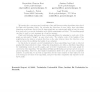Free Online Productivity Tools
i2Speak
i2Symbol
i2OCR
iTex2Img
iWeb2Print
iWeb2Shot
i2Type
iPdf2Split
iPdf2Merge
i2Bopomofo
i2Arabic
i2Style
i2Image
i2PDF
iLatex2Rtf
Sci2ools
SPAA
2009
ACM
2009
ACM
Routing without ordering
We analyze the correctness and complexity of two well-known routing algorithms, introduced by Gafni and Bertsekas (1981): By reversing the directions of some edges, these algorithms transform an arbitrary directed acyclic input graph into an output graph with at least one route from each node to a special destination node (while maintaining acyclicity). The resulting graph can thus be used to route messages in a loop-free manner. Gafni and Bertsekas implement these routing algorithms by assigning to each node of the graph an unbounded "height" in some total order. The relative order of the heights of two neighboring nodes induces a logical direction on the edge between them; the direction of an edge is reversed by modifying the height of one endpoint. In this work, we present a novel formalization for these algorithms based only on directed graphs with binary labels for edges. Using this formalization, we define a distributed algorithm for establishing routes in acyclic grap...
Acyclic Input Graph | Parallel Computing | SPAA 2009 | Special Destination Node | Well-known Routing Algorithms |
| Added | 25 Nov 2009 |
| Updated | 25 Nov 2009 |
| Type | Conference |
| Year | 2009 |
| Where | SPAA |
| Authors | Bernadette Charron-Bost, Antoine Gaillard, Jennifer L. Welch, Josef Widder |
Comments (0)

